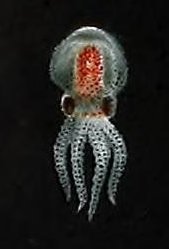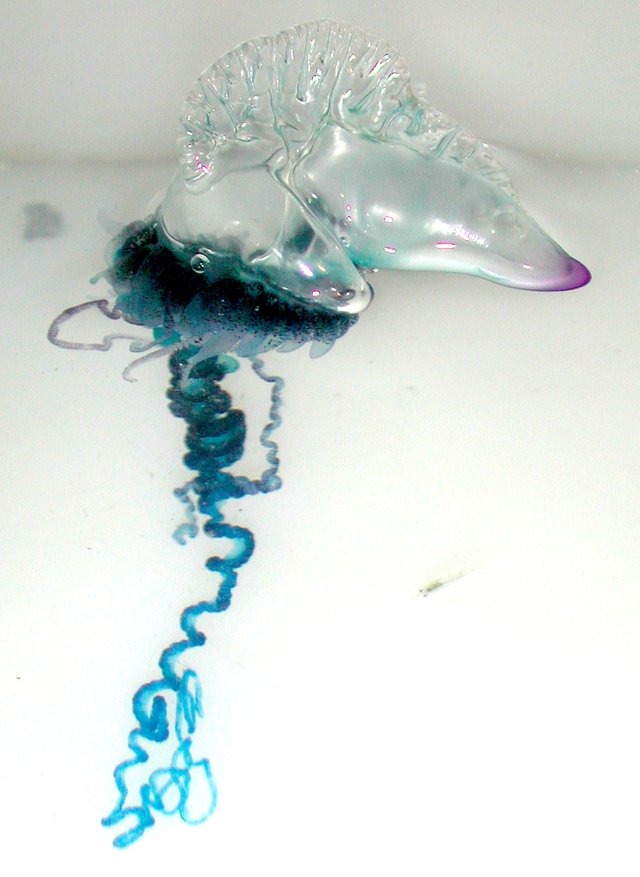The female blanket octopuses (Tremoctopus violaceus) is between 10,000 and 40,000 times the size of the males, making it the most sexually size-dimorphic multicellular animal we know of
Can you imagine if female humans were 40,000 times the size of the males? That would be absolutely absurd! We do so have some sexual size-dimorphism in humans, a term used to describe how different size the sexes of the same species is. In general, males are more muscular and bigger than females, but we’re not all that different. Some species have no sexual size-dimorphism at all, and you would not really be able to tell the sex of an animal by looking at it with a quick glance, but it is generally common to have at least some sexual dimorphism for mammals.
As you read in the title, the animal that we know of that is the most sexual size-dimorphic is the blanket octopuses (Tremoctopus violaceus). The females in this species of octopus often reach a size of about 2 meters, while the males are around 2.4 centimeters!
The blanket octopuses are very rare, so the best picture I could post of a blanket octopus without breaking any laws is a drawing from 1851. The drawing is Public Domain.
The weight ratio between the females and males are at least 10,000:1, meaning that for each gram the male weights, the female weights at least 10,000 grams. The 10,000:1 number is also believed to be a conservative estimate, and some researchers believe it’s closer to 40,000:1 (with males being only a quarter of a gram, with females weighing as much as 10kg).
The blanket octopus
A blanket octopus is not a species we know a lot about. They spend all their life in the pelagic zone in the open ocean, and we humans rarely encounter them, so out knowledge is a bit limited. A really interesting thing about them is that they have developed a long, transparent web that connects the dorsal and dorsolateral arms, giving them the impression of wearing a cape. This is also why they got named blanket octopuses.
Unfortunately I can’t find a good photo to illustrate this (that I would be allowed to repost here), so I suggest that you search for “blanket octopus” on Google to see it for yourself. It’s definitely a unique look!
Finding a male blanket octopus
As you might have expected, finding a male is much more difficult than finding a female. Up until a few years ago, no one had even seen a live specimen, but a group of Australia researchers changed this when they did “blackwater hangs” in the Great Barrier Reef – night dives suspended over deep water! (That sounds really terrifying by the way).
The male they encountered was only 2.4 centimeters in total length, and weighs 0.25g, but it was fully sexually developed, meaning that it was a grown individual.

This is a very young female blanket octopus, which looks a lot like a grown male. Image is Public Domain.
Why are the males so small?
The first question we should ask when we learn that the males are so small, is “why”, and the most likely answer is because of evolution and natural selection. Why would the males even bother growing big when they can deliver their genetic material from such a small body? Developing to a grown, sexually reproductive male will certainly be a lot faster with a tiny body compared to if they were to grow to 2 meters.
Another interesting aspect that could give an a clue as to why they are so small is that both males and small females have shown to carry the stinger of the Portuguese Man-of-War Jellyfish (Physalia physalis) in their tentacles. These stingers are highly venomous to anyone who touches them, but the blanket octopuses are apparently either immune or just very skilled at handling them without getting hit. This makes it an extremely good defensive weapon to use against predators that want to eat them, but once the females grow bigger, they are simply unable to get enough stingers to protect themselves anymore, or able to carry the stringers in their suckers without stinging themselves.

A Portuguese Man-of-War. This animal could kill if you you get stung by it! Image is Public Domain.
This means that the smaller blanket octopuses have a huge advantage over the ones who grow big, and could very well be one of the reasons why the males have adapted into staying very small.
There could also be other reasons that we have yet to learn about, but it’s very obvious that it’s a huge advantage for the males to stay so small, or else they would not have evolved to doing it.
Mating between the blanket octopuses
How would a two meter long female and a 2.4 centimeter long male even mate? I’m glad you asked! Octopus mating is very different from how humans or other mammals mate.
The male blanket octopuses have developed a large (in contrast to the others) reproductive arm that has a white spherical poach inside it. This reproductive arm is known as a hectocotylus, and it is used when mating. Upon meeting a female, the poach inside the arm will rupture, and the sperm is injected into the tip of this arm. This causes the entire arm to be severed, and the female will pick it up.
The female can then store the sperm-filled arm inside her own body until she decides to use it to fertilize her eggs. This might not happen right away, and she might want to grow bigger or wait for a better time with better conditions before she fertilizes them. The male on the other hand does not have long, and will most likely die within minutes of the act. No one has yet to observe whether or not he dies, but it just seems likely since no one has ever found a male with regenerated hectocotylised arms.
We need a bigger sample size!
I’m sure those of you who have studied a branch of science already see some of the problems with drawing too much information from the research I wrote about above. The big flaw is that they only found a single male blanket octopus during the data gathering part of the research.
I would say that this is a very interesting study, but it would certainly be nice to see some more males being captured to test whether or not the male from the research paper was really representative for the entire species. Some males have been found dead in plankton and fishing nets, but we have obviously gained limited information from these. They match with the size and weight, but it would still be nice to see a larger sample size of preferably live males.
It’s not bad science to publish findings made from a single observation, but it’s very important for the reader to keep the limitations in mind when they read about the findings.
Sources
- "First encounter with a live male blanket octopus: The world's most sexually size‐dimorphic large animal" by M. D. Norman , D. Paul , J. Finn & T. Tregenza.
Thanks for reading
About @valth
Hey, I'm @valth - the author of this post. I love to write about nature, biology, animals, nature conservation, ecology and other related branches of science, and I occasionally write about my life, about Steem or about random stuff as well. I'm trying my best to write at least one post every day, so make sure to give me a follow if you enjoy my content and want to see more of it.
Join the @valth community!
I love nothing more than to engage with my readers, so please join the @valth community in the comment section. You will definitely find more information about the topic, personal experiences, questions, and even opposing views down there, so don't miss out on learning more.
I always reward users who post good comments, so please take the opportunity to share your views and get a small upvote in exchange for it.
Yeh that's just a "slight" difference wow :O And probably a good thing that you explained octopus mating habits and how size doesn't matter as even though I know how octopi mate the first thing I thought of still managed to be "what the heck do they just swim in?" XD
They definitely have a weird method of mating. Most other octopus species have the ability to regenerate their hectocotylus arm after the mating though, so at least they don't all have to die :P
Interesting... Size disparity is intriguing...
And yes a larger data set is required for more conclusive answers...
I would rather '' Presearch'' it instead of googling... Lolzzz
Good point! I will try to remember to tell people to Presearch stuff instead of Googling stuff next time ;)
No, it would be terrible for me if the human females are 10,000 times bigger than males xD
Thank you for explaining these octopuses. I did not know about this ridiculous fact before.
Hehe, that's true. I'm glad you enjoyed learning a bit about these strange octopuses :)
Hahaha
They are very unique. I can't imagine how they will get married. Because octopus is very small compared to females. Can they be eaten?
Have a good day @valth
Good question. But I don't know. I think that they should be safe to eat, but I have no idea if they taste good.
Have a good day you too :)
Oe, i see my friend.
Thanks
How weird! Nature doesn't stop surprising.
Very nice post, well written.
Thank you! And yeah, there is definitely a lot of weird stuff going on in nature.
Nice amazing information I fallow you
Thanks, I'm glad you liked it :)
This post has been voted on by the steemstem curation team and voting trail.
There is more to SteemSTEM than just writing posts, check here for some more tips on being a community member. You can also join our discord here to get to know the rest of the community!